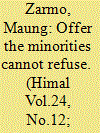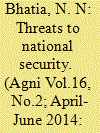|
|
|
Sort Order |
|
|
|
Items / Page
|
|
|
|
|
|
|
| Srl | Item |
| 1 |
ID:
132570


|
|
|
|
|
| Publication |
2014.
|
| Summary/Abstract |
After decades of isolation, Myanmar is now actively re-engaging with the global economy. For successful re-engagement, Myanmar needs to implement comprehensive economic reforms based on a shared vision of long-term economic development characterized by human-centred, sustainable, pro-poor, inclusive, high and balanced economic growth. In this paper, we propose five growth strategies: an "Agriculture Plus Plus" strategy; an export-oriented strategy; a foreign direct investment driven strategy; a two-polar growth strategy; and a domestic economic corridors development strategy. These strategies are used as guides to translate wide-ranging development agendas into a set of implementable policies, programmes, and projects.
|
|
|
|
|
|
|
|
|
|
|
|
|
|
|
|
| 2 |
ID:
126014


|
|
|
|
|
| Publication |
2011.
|
| Summary/Abstract |
In his Manifesto of the Communist Party (1848), Karl Marx wrote: 'The history of all hitherto existing society is the history of class struggles.' Such an assessment is only half-right when it comes to Burma's internal conflicts, of which ethnicity is of equal importance to class. Whether ethnicity is largely a matter of 'political choice', as many academics suggest today, has little relevance in the lives of these ethnic peoples. The Karen, Kachin, Mon, Shan, Karenni and others have chosen to hold on to their AK-47s or M16s in order to fight on. The unappealing alternative is surrender and subjugation at the feet of their uncompromising enemy in Rangoon and, since 2005, Naypyidaw.
|
|
|
|
|
|
|
|
|
|
|
|
|
|
|
|
| 3 |
ID:
130890


|
|
|
|
|
| Publication |
2014.
|
| Summary/Abstract |
India covers a total geographical territory of 2,87240 Sq. Lm (12,69,210 Sq, Mile) and according to the census conducted in 2011, the population of India is 1,210,193,422 that strategically makes it the seventh largest and the 2nd most populated country in the world. Geographically it is bounded by the Indian Ocean in the south, the Arabian sea on the west, the Bay of Bengal in the east and sharing land borders with Pakistan, on the west, China, Nepal and Bhutan in the north and the northeast, and Bangladesh and Burma in the east. in shares maritime boundaries with Pakistan in the west, Sri Lanka in south and Bangladesh in east and its islands of Andaman and Nicobar share with the Thailand and Indonesia.
|
|
|
|
|
|
|
|
|
|
|
|
|
|
|
|
|
|
|
|
|